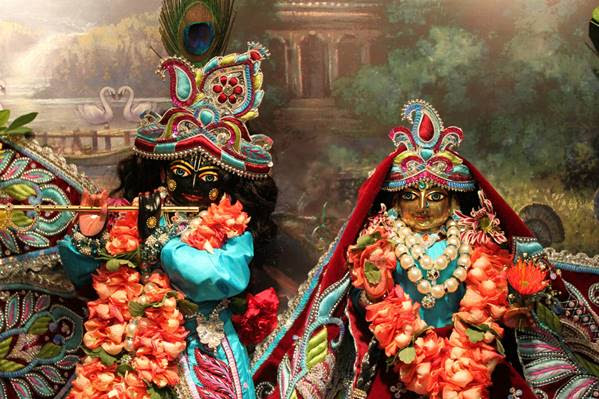(Kadamba Kanana Swami, 21 November 2012, Cape Town, South Africa, Evening Talk)
One maybe, or may not be, a gre at philosopher like Uddhava. Uddhava was a great devotee from Dwarka and Uddhava was a disciple of Brihaspati who is the spiritual master of the demigods. Uddhava was very, very learned and he was also a great, loving devotee of Krsna but he had a bit of slant towards learning, so he was always philosophizing. Krnsa sent him to Vrndavan and then he realized that he is not a devotee at all. When Uddhava saw Mother Yasoda, when he saw the gopis, he realized. He tried to preach them, “Do you know that Krsna is the Supreme Lord?”
at philosopher like Uddhava. Uddhava was a great devotee from Dwarka and Uddhava was a disciple of Brihaspati who is the spiritual master of the demigods. Uddhava was very, very learned and he was also a great, loving devotee of Krsna but he had a bit of slant towards learning, so he was always philosophizing. Krnsa sent him to Vrndavan and then he realized that he is not a devotee at all. When Uddhava saw Mother Yasoda, when he saw the gopis, he realized. He tried to preach them, “Do you know that Krsna is the Supreme Lord?”
I mean (laughing), they couldn’t even hear it, “Huh? What are you talking about?”
“Krsna is all pervading.”
“All pervading? No! He’s gone to Mathura! We’re suffering, we’re suffering like anything. Krsna left Vrndavan, you know, he left Vrndavan and you’re telling us that he’s all pervading? When is he coming back? Please, you know, after you’ve finished with all that, that Krsna’s all pervading, do you have any news of Krsna? Tell us something about Krsna. How is he doing? Is he sometimes thinking of this mother?”
Like this, they did not care about jnana (knowledge); they couldn’t care less but Uddhava had a bit of that interest in the opulence of Krsna. So it is interesting. In the beginning, philosophy is very important because it keeps us on the path. Otherwise we go here, we go there, we go everywhere. In this way,
yadā te moha-kalilam
buddhir vyatitarisyati
tadā gantāsi nirvedam
śrotavyasya śrutasya ca (Bhagavad-gita 2.52)
When your intelligence has passed out of the dense forest of delusion, you shall become indifferent to all that has been heard and all that is to be heard. Only Krsna and that stage we want.

 It is so inspiring to hear how the devotees came to the Krishna consciousness, especially in the BTG magazine section, "How I Came to the Krishna consciousness." Except for every such story there are many stories you never hear, of "How I Did Not Come to the Krishna Consciousness." They do not publish in the BTG because those persons are not going back to the Godhead. Maybe next life or so Read more ›
It is so inspiring to hear how the devotees came to the Krishna consciousness, especially in the BTG magazine section, "How I Came to the Krishna consciousness." Except for every such story there are many stories you never hear, of "How I Did Not Come to the Krishna Consciousness." They do not publish in the BTG because those persons are not going back to the Godhead. Maybe next life or so Read more ›  It is so inspiring to hear how the devotees came to the Krishna consciousness, especially in the BTG magazine section, "How I Came to the Krishna consciousness." Except for every such story there are many stories you never hear, of "How I Did Not Come to the Krishna Consciousness." They do not publish in the BTG because those persons are not going back to the Godhead. Maybe next life or so Read more ›
It is so inspiring to hear how the devotees came to the Krishna consciousness, especially in the BTG magazine section, "How I Came to the Krishna consciousness." Except for every such story there are many stories you never hear, of "How I Did Not Come to the Krishna Consciousness." They do not publish in the BTG because those persons are not going back to the Godhead. Maybe next life or so Read more › 







 We are pleased to invite you, your family and friends for the Christmas Party & a Thank you program at ISKCON Brampton.
We are pleased to invite you, your family and friends for the Christmas Party & a Thank you program at ISKCON Brampton. 


 Dallas Morning News,
Dallas Morning News,






 Last week we had a grand opening of a new Hare Krishna Centre in Batticaloa, Eastern Province of Sri Lanka. With the blessings of the GBCs and support of ISKCON Colombo authorities we had a wonderful two days festival. The lightning board of "Hare Krishna Centre" on the main road has now become a new land mark of the City and a new bus stop's name.
Last week we had a grand opening of a new Hare Krishna Centre in Batticaloa, Eastern Province of Sri Lanka. With the blessings of the GBCs and support of ISKCON Colombo authorities we had a wonderful two days festival. The lightning board of "Hare Krishna Centre" on the main road has now become a new land mark of the City and a new bus stop's name.  Travel Adventures of a Krishna Monk
Travel Adventures of a Krishna Monk  I went to a monthly event called Mantra Lounge in Neal’s Yard, Covent Garden. This event usually consists of Kirtan (congregational chanting of sacred mantras), Meditation & a Vegetarian Feast. Last Friday they had Chakrini as special guest, who happens to be my favourite Kirtaneer, and as a bonus they were offering a Vegan Feast (yes, I am a Vegan). To give you an idea about Chakrini, you have to imagine a celestial being having taken birth on this planet to bring joy and enlightment to us lost souls through the most powerful sound vibrations put into melodies for easier digestion
I went to a monthly event called Mantra Lounge in Neal’s Yard, Covent Garden. This event usually consists of Kirtan (congregational chanting of sacred mantras), Meditation & a Vegetarian Feast. Last Friday they had Chakrini as special guest, who happens to be my favourite Kirtaneer, and as a bonus they were offering a Vegan Feast (yes, I am a Vegan). To give you an idea about Chakrini, you have to imagine a celestial being having taken birth on this planet to bring joy and enlightment to us lost souls through the most powerful sound vibrations put into melodies for easier digestion